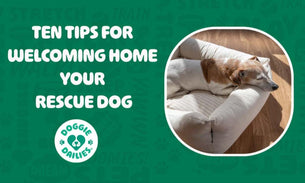So you’ve decided to adopt a dog! It is both exciting and overwhelming for both you and your dog. In order to create a smooth transition, it is important for both you and your dog to establish clear boundaries and maintain structure. It’s a new relationship for both of you. Creating trust is key! Here are 10 tips to help you welcome home your adopted, furry, family member:
- Be prepared. Before you adopt your dog or even go to the shelter, be sure to do some research on dog breeds. Consider your lifestyle, living arrangements, activity level, etc. Try to identify breeds that fit your lifestyle. Shelters do their best to identify the breed or mix. Knowing what breeds are the best fit for you will help you make the best decision for you and your future dog.
- All family members on board. Caring for a dog requires all members of a house to be in agreement. From having a dog in the first place to the house rules, everyone needs to be on the same page. Plan who will take on certain responsibilities, what’s allowed, and what’s not allowed. Consistency is key with dogs; without it, dogs will become confused and make their own rules.
- Shop for the basics. You’ll need a leash, collar, a bed, bowls, waste bags, food, and obviously treats. If you know your new pup’s name, buy and ID tag right away! Be sure you put the tag on your dog immediately - don’t wait until you get to your car. These are the key items that you will need in place even before you bring your new dog home. If you plan on crate training, bring your pup shopping to be sure you get the proper size crate.
- Be Patient. This is a big change for both of you, especially your new dog. Every dog is different. It takes some dogs a little longer than others to get comfortable in their new home and show their true personality. Their old life may not have been easy and trusting can be hard. Be patient as your pup adjusts to their new life.
- Establish a routine and structure. From the moment you bring your dog home, establish a routine and structure. Keep your feedings and walks at the same time every day. Use the same signal or call word for those activities each time. A reliable routine will help your dog feel safe and secure.
- Create a space just for your dog. Everyone needs alone time, even dogs. Creating a place for your pup to enjoy alone time is important for reducing anxiety. Your pup will be reassured that they have their own safe space to go to when they need to relax. Whether it’s a crate, a room, or a corner of a room, make sure your pup has their own space. It will help make them feel safe as they adjust.
- Slowly introduce new things and people. It is very exciting to add a new member to the family, but take it slow when introducing new people and things into your pup’s life. Too many new things at once can be overwhelming. Try introducing one new person or dog to your dog each day. Be sure to save the first trip to the dog park for off-hours.
- Find a Veterinarian. It’s very important to find a veterinarian and set up an appointment to get your pup checked out. If you have an existing relationship with a vet, that is great. Be sure to take your pup to a veterinarian for a health check and to make sure they have all their vaccinations.
- Slowly Transition to new dog food. Often shelters will provide you with a bag of food that your pup has been eating. If you plan to switch food brands, be sure to do it slowly. Incorporate some of the shelter food with the new food to gradually switch your dog over. An abrupt change in food can cause digestion issues. It’s always a great idea to introduce a probiotic supplement during a food transition to help ease indigestion.
- Avoid common mistakes. Even with good intentions, many pet owners fall into common mistakes that lead to bad habits with their pup. Not setting clear boundaries, spoiling with too many toys, failing to set a routine, etc. Check out these common mistakes to avoid.








